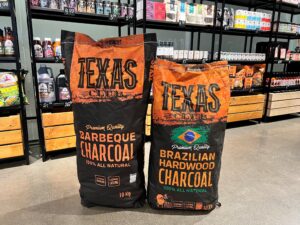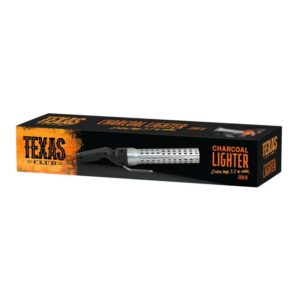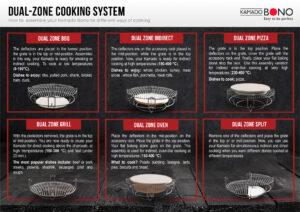Hibachi safety Instructions
MAIN PARTS OF THE GRILL
The Kamado Bono grill consists of:
• A body, which includes two vents and a thermometer
• A firebox, fire ring, and ash grates
• A cooking system: stand, grill grates, cross, and deflector
• The larger models include a stand with wheels, side shelves, and ash cleaning systems
PLEASE NOTE! The opening at the bottom of the firebox should always be aligned with the bottom vent.
Charcoal
• Only natural hardwood charcoal can be used in Kamado Bono grills
• Firewood, pressed charcoal briquettes, or other fuels are not suitable for these grills
• It is suitable to use dry fire starters or electric lighters to ignite the charcoal
• Flammable liquids are prohibited
• There is no need to remove the charcoal left after grilling. By closing both vents of the grill, the charcoal will cool down and can be used again for the next grilling session

PLEASE NOTE! We recommend using high-quality hardwood charcoal. Our grillers choose "Texas Club" charcoal.
LIGHTING THE GRILL
• Pour some charcoal into the firebox. For very long cook times or very high temperatures, use more charcoal; for shorter cook times, use less
• The firebox is full when the charcoal occupies about 80% of it
• Fully open both vents of the grill
• Ignite the charcoal using an electric starter or by placing a lit dry fire starter on the charcoal
• Once the charcoal starts burning, close the grill lid and monitor the temperature to prevent it from rising too quickly

PLEASE NOTE! When lighting a new grill for the first time, it is important to maintain a temperature no higher than 150 degrees Celsius for at least an hour. Kamado Bono can be used all year round.
TEMPERATURE CONTROL
• The temperature of Kamado Bono grills is regulated by vents
• The opening of the bottom vent has the greatest impact on temperature increase
• When starting the grill, as the thermometer readings approach your target temperature (about 10-20 degrees away), close the bottom vent.
• Once you reach the target temperature, slightly adjust the top vent as needed
• If you need to raise the temperature during cooking, open the bottom vent wider
PLEASE NOTE! The grill is not a stove, and the temperature inside it rises and falls more slowly, so be patient and avoid rushing to adjust the vents. For example, when you place a lot of cold meat on the grates, the temperature shown on the grill's thermometer will drop, but there is no need to open the vents to raise it because as the food warms up, the temperature will return to the desired position.
GRILL CLEANING
A comprehensive cleaning of the Kamado Bono grill should not be done before every use, but rather when there are visible heavy grease deposits on the fire ring, deflector, firebox, and there is more soot in the grill than usual. Comprehensive grill cleaning:
• Remove old coals and ashes from the grill (including from the firebox, where ashes accumulate over time), brush the inside of the grill with a wire brush to remove any accumulated dirt, and then put back the internal parts: firebox, ash tray, fire ring
• Add fresh charcoal to the grill, light it up, and let it heat up to 200 degrees Celsius, then set up the two-zone cooking system (place the deflector with the dirty side towards the coals) and let the temperature rise to 280-300 degrees Celsius (no more), maintain this temperature for 20 minutes and close the bottom vent. After another 15-20 minutes, close the top vent as well
• Once the grill has cooled down, if there are any remaining residues, wipe them off with a wire brush
PLEASE NOTE! After higher temperatures, when the grill has cooled down, tighten the horizontal screws that connect the grill rings. Important! The interior of the grill should not be cleaned using cleaners or water.
GRILLING ON DIRECT HEAT
• This is a method of cooking where food is prepared over an open flame
• This method is commonly used for (up to 5 cm thick) beef steaks, various cuts of meat, meat patties, skewers, and the like
• Direct heat is also used when cooking in pans or skillets: omelets, potato or flour pancakes, paella, etc.

GRILLING ON INDIRECT HEAT
• Indirect grilling function is best suited for cooking larger pieces of poultry and meat as they require more time to prepare
• Choose thicker cuts of meat (5 cm thick or more) or cuts with bone, such as chicken parts, ribs
• When cooking slowly, a deflector placed between the food and the charcoal shields the food from open flames. The food cooks due to the heated air flow and heat retained by the walls and lid of the Kamado Bono grill
• If cooking at 140 degrees or below, place the deflector in the lower position; if at a higher temperature, place the deflector in the upper position.

HOT SMOKING
• For hot smoking, we recommend using smoking chips.
• Light up the grill, and stop the temperature rise when it’s about 10-20 degrees below your target temperature (for hot smoking, the temperature typically ranges from 70 to 120 degrees Celsius, depending on the dish)
• Place several smoking chips on the charcoal in different spots
• When hot smoking, use a thermometer to measure the internal temperature of the food to know when your dish has reached the optimal internal temperature
PLEASE NOTE! Just because you can't see smoke coming out of the grill doesn't mean the smoking process for your dish has stopped. Important! Meat absorbs smoke best while it's cold, during the first two hours.
COLD SMOKING
• Ideal conditions for cold smoking are when the outdoor temperature is positive but not higher than 8 degrees Celsius.
• Cold smoking requires the use of a smoking spiral (our recommended Texas Club spiral is suitable for all Kamado Bono sizes from Minimo to Grande Limited).
• The spiral is filled with wood dust (different types of dust vary in aroma intensity, shade given to the meat, and burning time).
• To prepare the grill for cold smoking, remove all charcoal and ashes, place the spiral filled with dust at the bottom of the firebox, and cover it (it’s most convenient to do this using a tea candle).
• During cold smoking, the grill vents should be open very minimally
• It is recommended to use a deflector to prevent dust from getting stuck when meat drips fluid
• It is advisable to make a roof from foil over the smoked product from the second tier of grates to prevent condensation, especially when the outdoor temperature is low
Smoking duration:
Thermal processed products (meat, poultry, cheese, butter, nuts, etc.) require 4-8 hours.
The more moisture in the meat, the longer the smoking process takes. Moisture removal is aided by the use of salt in the preparation process.
For many products, a weight loss of up to 30% is entirely normal.
Properly prepared products may require only 12-24 hours of smoking, but if you trust your abilities in preparing meat (using preservatives, nitrite salts), you can extend the process significantly – the taste of the product will be more pronounced and vivid.
PLEASE NOTE! Cold smoking doesn't prepare your product – all the magic happens when you marinate the product with a dry or wet marinade BEFORE smoking. The salt in the marinade removes excess water from the product, kills some bacteria, and so on. Cold smoking itself preserves the product (helping to maintain its quality and flavor for longer), adds extra aroma and taste. Safety! Cold smoking is a risky, knowledge-intensive process. Bacteria are most easily introduced into food products when the ambient temperature is between 4.4°C and 60°C. Cold smoking won't help avoid, for example, e.coli or botulism. Most bacteria are killed by salt during preparation.
MAIN ACCESSORIES
Baking Stone:
• A baking stone is essential for cooking in the Kamado Bono grill, such as pizzas, pies, kugelis, pastries, and more
• The baking stone should NOT be greased. It’s important to place pizza or other pastries directly on the stone only when the stone is already heated.
• The baking stone should NOT be washed. If it gets wet, there is a high probability that it will crack next time it is used. If there are any impurities on the stone, they can be gently removed with a dry cloth or a soft brush. When using it again, place the stone with impurities facing downwards
• The baking stone and the deflector are used together and cannot replace each other. When grilling pizza, place the deflector on the grates, then the cross, and then the baking stone. When baking pies and other pastries, the deflector is placed in the upper position on the cross, and the baking stone is placed on the grates.
Food Thermometer:
• An instant food thermometer is used when grilling over direct heat, for example, steaks, burgers, kebabs. We recommend the instant electronic INKBird thermometer, which accurately and quickly displays the temperature
• Probe thermometers are used when grilling over indirect heat, or when hot smoking food. The thermometer probes are inserted into the meat and left in place throughout the entire process. The temperature is visible on both the thermometer screen and the mobile app
• We recommend the 4-probe smart INKBird thermometer
Cast Iron Grates and Griddle:
• Cast iron grates and griddle are used for grilling only over direct heat, in cases where we want the food to be placed directly on the grates for searing
• They are commonly used for grilling steaks, meat patties, burgers, seafood
• On the griddle, you can also cook pancakes, eggs, small vegetables, and more
Also, every grill enthusiast should have these accessories:
• Heat-resistant gloves – for hand safety
• Wire brush – to clean the grates after each grilling session
• Tongs and spatula – for easy flipping, placing, and removing food from the grill
Kazan pot:
If you plan to cook soups, stews, or pilaf in the Kamado Bono grill, purchase a kazan pot or enameled cast iron pot. We recommend choosing a ready-to-use, polished Uzbek Namagano kazan “Texas Club” and/or an enameled cast iron pot Grand Feu.
PLEASE NOTE! It is very important to choose the right size baking stone for your grill: Kamado Bono Grande Limited - 42 cm, Kamado Bono Grande/Media/Žalgiris – 36 cm, Kamado Bono Minimo – 30 cm, Kamado Bono Picnic – 23 cm. Probe thermometers are not suitable for measuring the temperature when grilling food directly over heat.